Photography Secrets from One of the World's Top Shooters
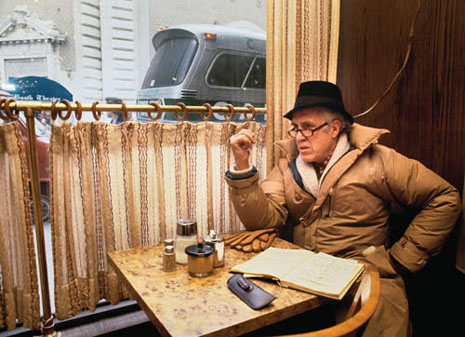
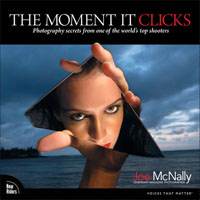
Excerpted from The Moment It Clicks by Joe McNally. Copyright 2008. Used with permission of Pearson Education, Inc., and New Riders
Wing It
Sometimes, you just gotta wing it. Got a job to shoot a photo portfolio of the overlarge freshmen NCAA hoopsters for Sports Illustrated. Started conjuring. One kid, Brandan Wright, had a wingspan of 7’4′. Okay, Batman comes to mind. Magazine liked the wings idea, but wanted them white. Cool…just switched screens in my head to X-Men 3.
Now try finding wings for somebody six-eleven with arms that don’t stop. It ain’t easy. My studio manager Lynn, who is a magical producer, started making phone calls and after a lot of dry wells, finally found the wing makers to the film and television industry, a small outfit in L.A. (where else?) called…Mother Plucker! I kid you not.
Money is a huge concern in any production, and these wings cost $3,400, last minute drop shipped straight to North Carolina. Steve Fine, DOP* at SI, called. “Can’t you go to a Halloween shop?” he asked. I reminded him of the size of our subject. Got the go ahead.
(Steve Fine and Jimmy Colton are currently the best one-two punch in picture editing, by the way. Steve has the calculus of sports in his head. He knows that if LSU beats Auburn this Saturday, he has to move three photogs on January 3rd to New Orleans for the Sugar Bowl ’cause LSU will go up against Florida State.
He doesn’t even have to look at a schedule. Jimmy has always been a voice of reason and counsel to young photographers, an open door, and a shelter from the storm. Together, they are formidable and fight the good fight.)
So we got the wings at 11:30 in the morning for a 1:00 p.m. photo shoot. I was being allowed 30 precious minutes of this very important 18-year-old’s life, no more. I had exactly an hour and a half to figure out how to hang these wings, stage and light the photo, and come up with at least two different solutions.
How to Get This Type of Shot
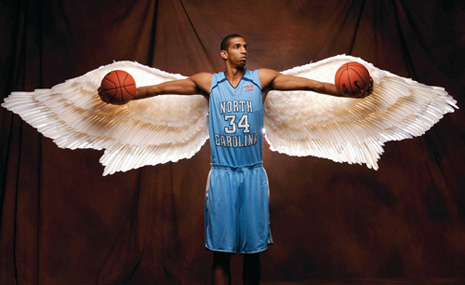
Okay. Usual deal. Speed lighting. Overhead softbox for him, small spot for background. Now the wings. Clamped ’em to the boom arm of a C-stand and sand bagged the heck out of it. Then put three strobe heads with magic arms on the same stand, all with honeycomb spot grids**. The whole rig looked like a science project gone bad.
Fanned the heads out desperately trying to get an even spread for backlight on the wings. They gotta look heavenly, right? So backlight’s the deal. Got it close enough to work just as Brandan came around the corner. Retouching took it the rest of the way.
Like much location work, this one was truly a wing and a prayer.
Ring Light
The ring light*** needs to be used…carefully. It has gotten a bit of a bad rap, probably from overuse in those downtown magazines with catchy names that usually last for about two issues and run page after page of disaffected, outlandishly dressed young people, apparently high on some form of illegal substance, staring vacantly at the camera with a circular highlight in their overlarge pupils.
It’s too bad, because when used properly and judiciously, it is a pretty snappy light that edges out your subject with the clean and definitive efficiency of a drill press. Throw in a bit of hair, makeup, styling, a fishnet cat suit, a killer look, and oh my! Have to be careful tipping it around too much though, ’cause at an unfortunate angle it produces shadows that can turn even a shimmering sex goddess into something that dropped out of the ugly tree.
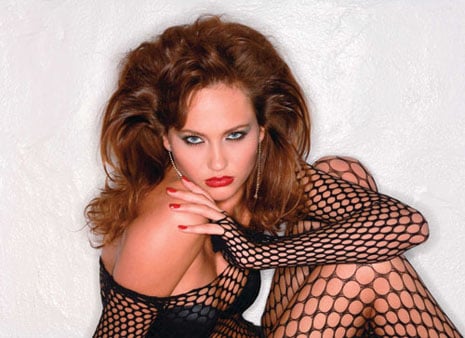
Bring a Chainsaw
I was sent to the Southwest to photograph a Tyrannosaurus head for the cover of Discover.
Now this T. rex head turned out to be a realistic-looking, eight-foot hunk of polyurethane that was in the sculptor’s garage, gathering dust. This is a typical assignment for me. Go make a national magazine cover out of a grime-laden piece of plastic.
We cleaned it, loaded it into a pickup, and trucked it out into the desert area, which was actually part of a national park. I rented a heavy-duty crank lift and a chainsaw, and got some rope and lumber. I’m an overgrown adolescent who saw Jurassic Park too many times and I wanted this puppy coming out of the trees, just like on the big screen. We found a tree, made sure no park rangers were around, chainsawed the $#!& out of it, and stuffed the lift in there. Then we took some of the branches and A-clamped them to light stands, lit the whole thing up Hollywood-style (shot at dusk), and got outta Dodge.
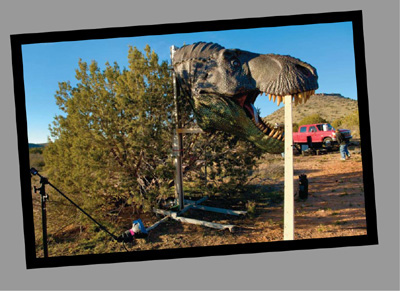
Tech Note: It was my first shoot with the Nikon D2X. Nikon had squirreled me away an early prototype. I’d been shooting with the D2H, and with my first few frames from the D2X, I saw the colors pop and knew, digitally speaking, we weren’t in Kansas anymore.
How to Get This Type of Shot
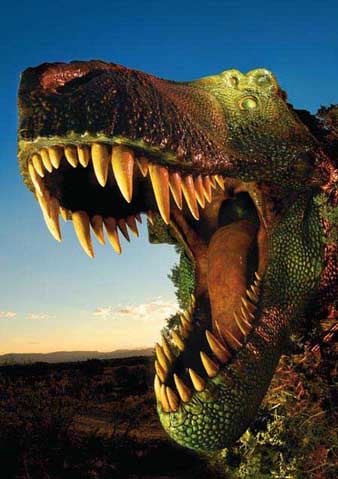
A shot like this depends on really defined, colorful splashes of light. When using gels to create these colors, it is best to use honeycomb spot grids. This shot was “spot grid city.” Big, broad sources of light don’t work with gels, because the different colors overlap and bleed into each other. One spot with a green gel was just out of frame by his eye. There’s a light with a tight grid and a red gel in the tree lighting his neck. There’s a Nikon hot shoe flash inside his mouth—in the lower jaw—giving some detail to his tongue, and there’s another spot grid to the left of the camera lighting his nose and upper row of teeth. This shot was taken with a 12–24mm wide-angle zoom.
Get There Early
I get there early. What can I say? I was raised Irish Catholic, so I feel guilty about stuff I’m not even responsible for. If I’m not in the parking lot two to three hours ahead of my appointment or assignment, I feel guilty. If I’m ever outright late, I feel like I gotta recite a frikkin’ Novena.
This has benefits as an assignment shooter. You get the best parking spots at events, for instance. The security guys can’t believe you just showed up at 6:00 a.m. for an event that evening, but no matter. So many people think I’m odd, I’ve given up worrying about it.
Even for local jobs, it’s good to get there early. In New York, I was assigned to shoot a bunch of actors doing public readings in an effort to save some of the older, historic Broadway theaters. It was cool. Some very famous theater people gathered and gave stirring public readings to save the old playhouses.
Didn’t work, of course. Money was at stake, and when that goes down, even having Lauren Bacall on your side don’t matter. The furry creative types are swell, but it was like sending shovel-toting peasants up against the Vikings.
The theaters went down, but the readings were great to shoot. It was like having a play for free right there in the street. I got there way early and ducked into a coffee shop, eternal refuge and impromptu office of the freelancer. Turned around, and there was Jason Robards rehearsing his lines.
You have to choose your strategies here. Years ago, I was assigned to cover the circus-like trial of Sid Vicious in New York City, which basically meant hanging around the courthouse all day to no photographic avail whatsoever. I mean, there were no pictures except for some of Sid’s punk friends who were hanging around as a show of support for their crackpot, unwashed, misogynist leader in spirit and kind. So I followed a group of these into the greasy spoon of the courthouse cafeteria, sat at the counter across from them, and ordered coffee. After a moment or two, I quietly snapped a frame with my Leica. This produced a baleful glare. Another snap.
Another glare. Another snap, and this time a snarl: “If you fookin’ take another photo of me, I’ll fookin’ kill ya!” At this point, I’m in for a penny, in for a pound, and I reach down to my camera bag and pull out a motor-driven F2 with a Vivitar and start pounding flash pictures. He came right over the counter at me.
There are, perhaps, better ways to break the ice. Like walk right up to your subject and ask.

Mr. Robards couldn’t have been more gracious, or more wonderfully oblivious to being photographed.
Stuff like this happens in New York when you’re there early.
* DOP is Director of Photography. He’s the guy that controls my air supply — he assigns the story, has control over the overall direction of photography, and is the main tap. Everything flows from him.
** Honeycomb Spot Grid: A circular metal grid (that looks like a honeycomb) that goes over your strobe head and limits the spread of the light.
*** Ring Light: A circular light source that wraps around the barrel of the lens. Produces a hard, shadowless light. Very popular with fashion photogs.
This article was last modified on January 5, 2023
This article was first published on May 30, 2008



